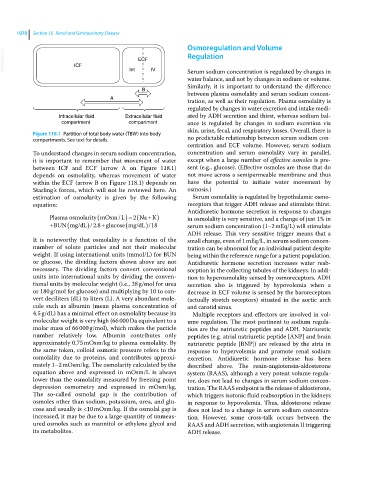Page 1132 - Clinical Small Animal Internal Medicine
P. 1132
1070 Section 10 Renal and Genitourinary Disease
Osmoregulation and Volume
VetBooks.ir ICF ECF Regulation
IV
Int
Serum sodium concentration is regulated by changes in
water balance, and not by changes in sodium or volume.
Similarly, it is important to understand the difference
B
between plasma osmolality and serum sodium concen-
A
tration, as well as their regulation. Plasma osmolality is
regulated by changes in water excretion and intake medi-
Intracellular fluid Extracellular fluid ated by ADH secretion and thirst, whereas sodium bal-
compartment compartment ance is regulated by changes in sodium excretion via
skin, urine, fecal, and respiratory losses. Overall, there is
Figure 118.1 Partition of total body water (TBW) into body
compartments. See text for details. no predictable relationship between serum sodium con-
centration and ECF volume. However, serum sodium
To understand changes in serum sodium concentration, concentration and serum osmolality vary in parallel,
it is important to remember that movement of water except when a large number of effective osmoles is pre-
between ICF and ECF (arrow A on Figure 118.1) sent (e.g., glucose). (Effective osmoles are those that do
depends on osmolality, whereas movement of water not move across a semipermeable membrane and thus
within the ECF (arrow B on Figure 118.1) depends on have the potential to initiate water movement by
Starling’s forces, which will not be reviewed here. An osmosis.)
estimation of osmolarity is given by the following Serum osmolality is regulated by hypothalamic osmo-
equation: receptors that trigger ADH release and stimulate thirst.
Antidiuretic hormone secretion in response to changes
/
Plasma osmolarity mOsm L 2 NaK in osmolality is very sensitive, and a change of just 1% in
BUNmg/dL /.28 glucosemg//dL /18 serum sodium concentration (1–2 mEq/L) will stimulate
ADH release. This very sensitive trigger means that a
It is noteworthy that osmolality is a function of the small change, even of 1 mEq/L, in serum sodium concen-
number of solute particles and not their molecular tration can be abnormal for an individual patient despite
weight. If using international units (mmol/L) for BUN being within the reference range for a patient population.
or glucose, the dividing factors shown above are not Antidiuretic hormone secretion increases water reab-
necessary. The dividing factors convert conventional sorption in the collecting tubules of the kidneys. In addi-
units into international units by dividing the conven- tion to hyperosmolality sensed by osmoreceptors, ADH
tional units by molecular weight (i.e., 28 g/mol for urea secretion also is triggered by hypovolemia when a
or 180 g/mol for glucose) and multiplying by 10 to con- decrease in ECF volume is sensed by the baroreceptors
vert deciliters (dL) to liters (L). A very abundant mole- (actually stretch receptors) situated in the aortic arch
cule such as albumin (mean plasma concentration of and carotid sinus.
4.5 g/dL) has a minimal effect on osmolality because its Multiple receptors and effectors are involved in vol-
molecular weight is very high (66 000 Da equivalent to a ume regulation. The most pertinent to sodium regula-
molar mass of 66 000 g/mol), which makes the particle tion are the natriuretic peptides and ADH. Natriuretic
number relatively low. Albumin contributes only peptides (e.g. atrial natriuretic peptide [ANP] and brain
approximately 0.75 mOsm/kg to plasma osmolality. By natriuretic peptide [BNP]) are released by the atria in
the same token, colloid osmotic pressure refers to the response to hypervolemia and promote renal sodium
osmolality due to proteins, and contributes approxi- excretion. Antidiuretic hormone release has been
mately 1–2 mOsm/kg. The osmolarity calculated by the described above. The renin‐angiotensin‐aldosterone
equation above and expressed in mOsm/L is always system (RAAS), although a very potent volume regula-
lower than the osmolality measured by freezing point tor, does not lead to changes in serum sodium concen-
depression osmometry and expressed in mOsm/kg. tration. The RAAS endpoint is the release of aldosterone,
The so‐called osmolal gap is the contribution of which triggers isotonic fluid reabsorption in the kidneys
osmoles other than sodium, potassium, urea, and glu- in response to hypovolemia. Thus, aldosterone release
cose and usually is <10 mOsm/kg. If the osmolal gap is does not lead to a change in serum sodium concentra-
increased, it may be due to a large quantity of unmeas- tion. However, some cross‐talk occurs between the
ured osmoles such as mannitol or ethylene glycol and RAAS and ADH secretion, with angiotensin II triggering
its metabolites. ADH release.

